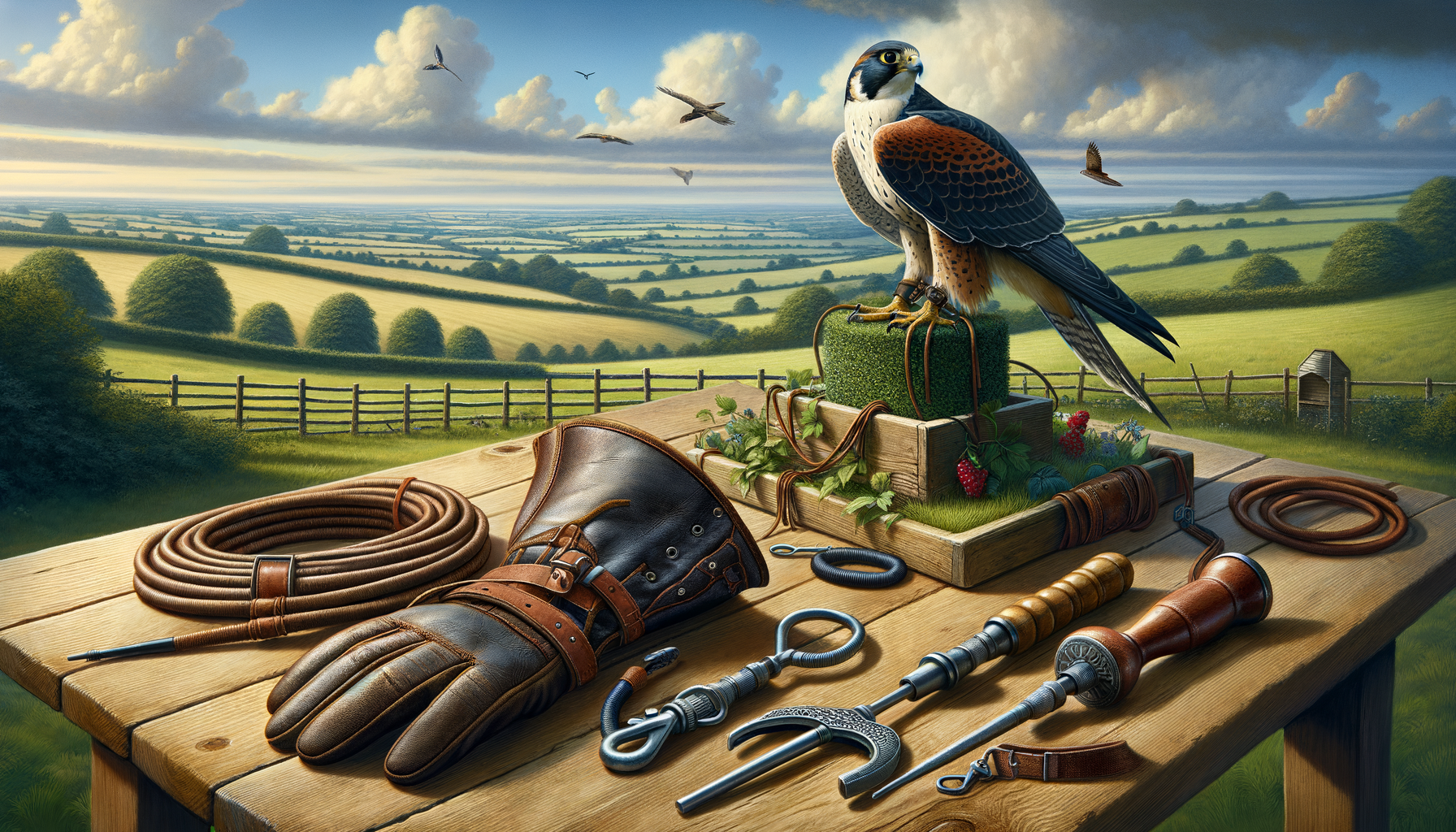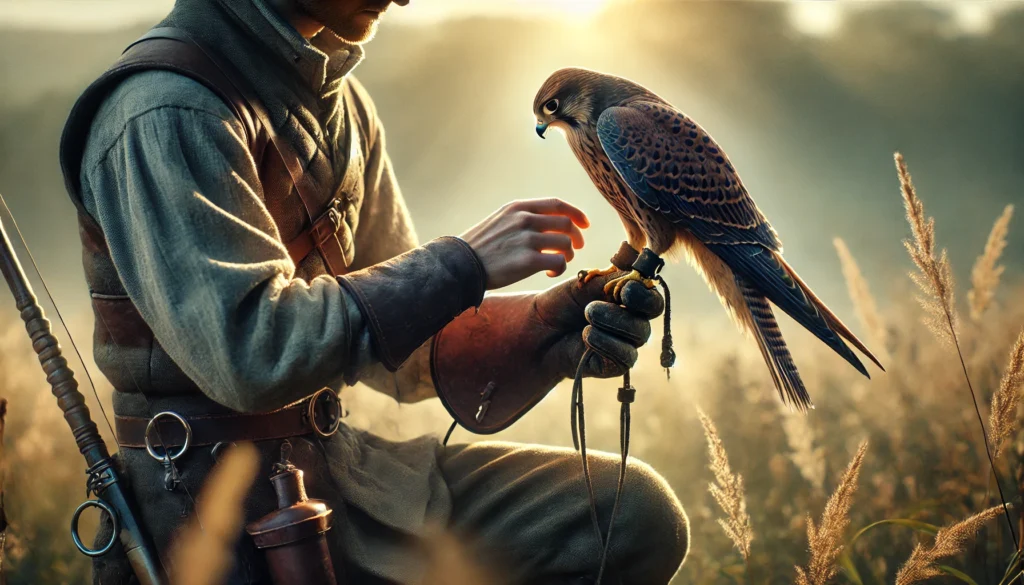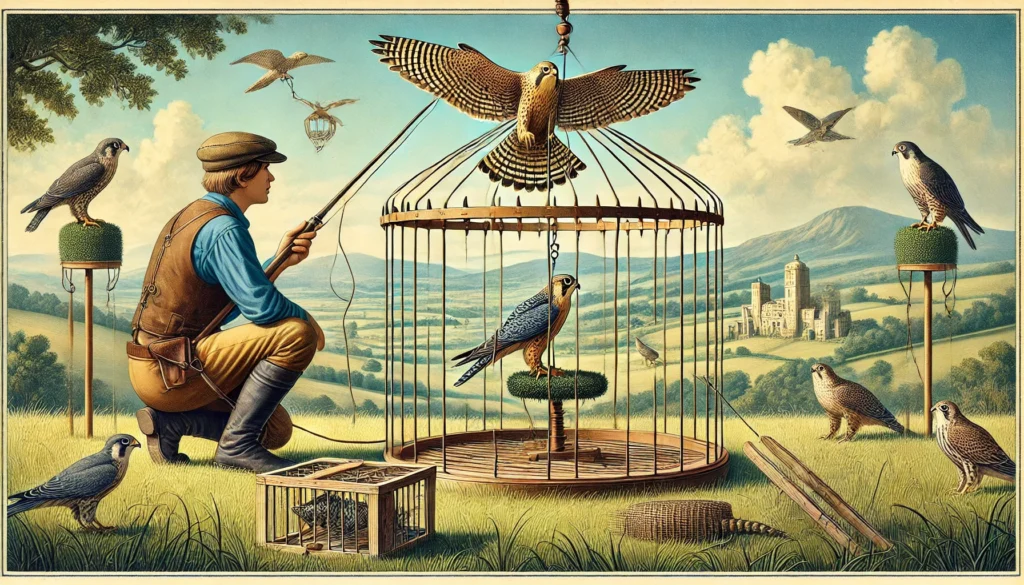Essential Safety Equipment for Falconry
- Gloves: Always wear thick, sturdy gloves to protect your hands from the raptor’s sharp talons.
- Jess and Leash: Use strong jesses and leashes to keep your bird secure and help in training.
- Hoods: Properly fitted hoods keep birds calm by covering their eyes when they’re not in flight.
- Perches: Ensure a variety of perches for your birds to rest on, both in their aviary and while training.
- Transport Boxes: Use well-ventilated transport boxes to safely move your birds from one place to another.
- Telemetric Equipment: Attach tracking devices to help locate your bird if it flies away during training.
- First Aid Kits: Always have a well-stocked first aid kit for treating minor injuries to your bird or yourself.
- Leg Bands: Use leg bands for bird identification and to track health records.
Discover the Vital Role of Safety Equipment in Falconry
Imagine you’re a brave Irish knight, setting off on a quest to find a legendary treasure deep in the heart of the emerald isle. Just as you’d never forget your sturdy shield and trusty sword, falconers must gear up with the right safety equipment to protect both themselves and their majestic birds of prey. Here at Learn Falconry, we know that proper gear is crucial for a safe and enjoyable falconry experience.
Falconry is an ancient and thrilling practice, but it comes with its own set of challenges and risks. Just like that knight wouldn’t tackle a dragon without armor, falconers shouldn’t engage with their birds without the right safety gear. This article explores the importance of safety equipment in falconry, from gloves and hoods to perches and ties, ensuring both human and avian adventurers face minimal risks.
Keep reading to dive deeper into the essential gear that makes modern falconry not just safe, but a fond adventure ‘ for both the falconer and their feathered allies.
Discover the Best Falconry Safety Gear for Your Practice
When you’re exploring the art of falconry, ensuring the safety of both you and your bird is absolutely crucial. Using appropriate falconry safety gear is essential for conducting this ancient practice in a safe and enjoyable manner. Without the proper protective falconry equipment, both falconers and their birds can face unnecessary risks. At Learn Falconry, we’re committed to guiding you through the best safe falconry practices.
Why Falconry Safety Gear is Important
Falconry is thrilling, but it can also be hazardous without the right equipment. Here’s a closer look at some important falconry safety gear you should consider:
- Gloves: One of the most critical pieces of protective falconry equipment is the glove. Falcons have sharp talons, and a falconer’s glove, often made from thick leather, protects your arm from potentially painful and damaging scratches. Check out more about gloves on falconry gloves.
- Jesses and Leashes: These are essential for maintaining control over your bird. Jesses are straps attached to the falcon’s legs, while a leash keeps the bird tethered when necessary. Learn more about them on jesses and leashes.
- Hoods: A hood covers a falcon’s eyes, keeping the bird calm and reducing stress. It’s especially useful during transportation. Read about different types of hoods on types of hoods.
Essential Protective Falconry Equipment
Having the right safety equipment is just one part of the equation. Here’s why each piece of equipment is important:
- Telemetry and GPS Trackers: These tools are used to track and locate your bird if it flies away. Falcons can cover large distances quickly, making this equipment vital. For more details, visit GPS trackers.
- Mews and Housing: Having a secure place to keep your falcon is another crucial aspect of safe falconry practices. A comfortable and secure mews provide a safe environment for the bird when it’s not flying. For more information on mews, see mews and housing.
Practicing Safe Falconry Techniques
It’s not just about the gear’understanding safe techniques is equally important. Here are a few practices to keep in mind:
- Positive Reinforcement: Training your falcon using positive reinforcement helps to establish trust and control without causing stress or harm to your bird. If you want to delve deeper, visit positive reinforcement techniques.
- Regular Health Monitoring: Routine health check-ups and proper nutrition are essential to ensure your bird’s well-being. Find out more on falcon health and nutrition.
- Legal Compliance: Ensure that your falconry practice is compliant with local and international laws. For legal guidance, check legal aspects of falconry.
Practicing safe falconry not only protects you and your bird but also upholds the integrity of this historic art. Whether you’re a beginner or an experienced falconer, investing in the right safety gear and keeping up with best practices is key to your success in falconry. For more detailed guides and equipment options, explore the extensive resources on our website Learn Falconry.
Understanding Falconry Safety Equipment in 2024
Gloves and Gauntlets
Falconry gloves and gauntlets are crucial for protecting the falconer from the bird’s powerful talons. These gloves are typically made from robust materials like leather, elk, deer, and cowhide. Here are some essential features:
- Material: Durable and strong, ensuring protection for the falconer’s hands and forearms.
- Sizes: Gloves come in various sizes and lengths to fit different falconry needs, ranging from 11 inches to 15 inches.
Here is a table for easy reference:
| Glove Type | Length | Material |
|---|---|---|
| Full Cuff Gauntlet | 15 inches | Leather, Elk |
| Standard Glove | 11-14 inches | Leather, Deer |
Safety Leashes
Safety leashes are used to prevent the falcon from flying away and causing harm. They are designed for quick and simple use, allowing falconers to prepare their birds for casting in under a minute. These leashes are different from button, fox, or loop leashes and serve a specific safety function.
Perches and Blocks
Perches and blocks create a safe and stable environment for the falcon to rest during training or handling. Made from durable materials like stainless steel and astroturf, these perches are easy to clean and long-lasting.
Anklets and Jesses
Anklets wrap around the bird’s leg for a secure fit, while jesses attach to the anklet. Jesses can be adjusted depending on whether the falcon is perching or flying.
Modern Technology Integration
Modern falconry equipment often features advanced technology, such as GPS trackers and transmitters, improving the safety and monitoring of the birds.
Sustainability Features
Some falconry equipment is crafted with safer chemicals for both humans and the environment. Organizations like OEKO-TEX STANDARD 100 certify these products, testing them for harmful chemicals.
Conservation Efforts
Suppliers of falconry equipment often contribute to environmental conservation by donating part of their sales to related efforts. Falconers also play a role in conservation by releasing trained birds back into the wild or participating in wildlife rehabilitation.
Availability and Price Range
Falconry safety gear is widely available from multiple online retailers, with prices ranging from $10 to over $100, depending on the type of gear and its quality. Many suppliers offer fast worldwide shipping, ensuring quick access to necessary equipment.
Here is a table showing the typical price range for various falconry safety gear:
| Equipment Type | Price Range |
|---|---|
| Gloves | $20 – $100 |
| Safety Leashes | $10 – $50 |
| Perches and Blocks | $30 – $150 |
Quality and Durability
Falconry safety gear is designed to be durable and withstand frequent use. High-quality items from reputable suppliers ensure that falconers can rely on their equipment over time.
Registration and Exams
To become a certified falconer, there are specific registrations and exams. For instance, the Falconry examination is scheduled for April 12, 2024, and candidates must register by April 10, 2024.
License Requirements
Different licensing stages exist in falconry:
- General Falconer License: Requires the applicant to be at least 18 years old with a current hunting license.
- Master Falconer License: Requires experience as a General Falconer for at least 3 years along with additional criteria.
Facility and Equipment Inspections
Falconry facilities and equipment must meet national standards and are subject to inspections by relevant authorities.
Annual Reporting and Legal Compliance
Licensed falconers must submit an annual report by December 31 each year and comply with Environmental Conservation Laws and national regulations to ensure ethical and legal practice.
By understanding and adhering to these guidelines and using appropriate safety equipment, falconers and their birds can enjoy a safe and enriching experience in falconry.
Wrapping Up Your Falconry Safety Journey
In the fascinating world of falconry, safety is crucial for both falconers and their birds. Protective equipment plays a key role in ensuring that everyone involved is safe and comfortable during training and hunting adventures.
Key Safety Gear:
- Gloves and Gauntlets: Essential for shielding your hands and forearms from the strong talons of falcons, these are typically crafted from tough materials like leather.
- Safety Leashes: Important for securely handling your falcon, preventing it from flying away or causing unintentional harm.
- Perches and Blocks: Provide stable surfaces for the birds during handling and training sessions, often made from durable materials like stainless steel.
- Anklets and Jesses: These ensure a secure yet comfortable fit for the bird’s legs, facilitating activities like perching or flying.
- Bewits and Swivels: Small yet significant, they help attach bells to the bird and provide secure connections to the leash.
More Than Just Equipment:
- Sustainability: Some falconry gear is designed with eco-friendly materials, ensuring both human and environmental safety.
- Conservation Efforts: By using modern equipment, falconers contribute to wildlife conservation, helping to support and protect raptor populations.
- Technological Integration: Incorporating technology like GPS trackers enhances bird safety and tracking during flights.
Final Takeaway:
Falconry is a rewarding lifestyle that requires dedication and the right gear to ensure a safe and enriching experience. The right equipment not only protects the falconer but also promotes the well-being and safety of the birds. Always ensure you have the best quality gear that meets your specific needs and complies with safety standards. By doing so, you’ll be well on your way to a fulfilling and secure falconry adventure!



